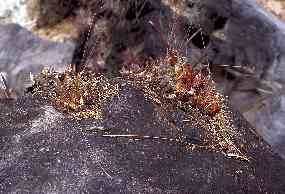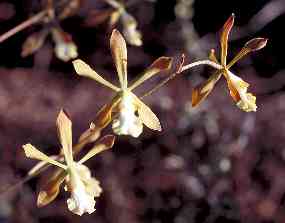Research and Conservation in Southern Sonora, Mexico
Encyclia adenocarpa (quiqui)
Creeping rhizomes give rise to hard, golf ball sized pseudobulbs topped with a pair of leathery semisucculent leaves. Two-foot branched inflorescences bear numerous one-inch dull brownish flowers with white lips in late spring into early summer. The flowers have a faint, sweet fragrance.
A common orchid on rock faces in humid canyons.
Description: Forming large colonies clinging to sheer rock. Rhizomes short, the pseudobulbs crowded, ovoid, green, to 5-9 cm long, 4.8 cm wide. Leaves paired, rarely 1, sometimes 3, linear, 20-36 cm long, 8-13.5 mm wide, thick, leathery and semisucculent. Inflorescences racemose to mostly paniculate, the flowering stalks 30-72 (-135) cm long. Flowers yellow-brown, 3-3.5 cm across, with a sweet fragrance in the morning and early afternoon, usually many on slender branches.
Sepals and lateral petals brownish: dark purple-red stripes on a yellowish background. Sepals oblanceolate, 15.5-18.8 mm long, 4.5-5.5 mm wide, moderately keeled, with a few scattered hairs basally on the upper surface, the apex broadly acute.Petals oblanceolate, 15.2-17.5 mm long, 3.0-4.5 mm wide, the apex acute to obtuse.
Lip petal 15.3-17.6 mm long, united to the basal one-third to one-half of the column, the middle lobe 6-7.5 mm long, 6-8 mm wide, white with faint purple-red and yellowish margins, the lateral lobes (auricles) yellowish, 3.5-3.7 mm long, 2.0-2.5 mm wide, the callus 4-9 mm long, concave, smooth, pure white, extending distally into 5 white ridges (crests).
Column cream-white, 9-11 mm long, 5 mm wide at apex, the wings ca. 1 mm wide. Pollinia thin, 0.9-1.3 mm long. Capsules ellipsoid, pappilose, the pedicellate portion 12-19.5 mm long, the body strongly angled, 17-25 mm long plus a prominent beak. (January-) May to July; fruits ripe January-June of the following year.
North-facing or shaded, riparian canyon rock-faces. Tropical deciduous forest and oak forest, especially at their ecotone. 350-900 m. Often growing with Oncidium cebolleta and bromeliads including Tillandsia capitata. SE Sonora and SW Chihuahua; southward to Guatemala.













